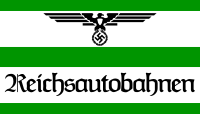
Back الرايخ أوتوبان Arabic Reichsautobahnen Czech Reichsautobahn Danish Reichsautobahn German Reichsautobahn Spanish رایشساتوبان Persian Reichsautobahn ID 라이히스아우토반 Korean Reichsautobahn Polish Ríšska diaľnica Slovak


The Reichsautobahn system was the beginning of the German autobahns under Nazi Germany. There had been previous plans for controlled-access highways in Germany under the Weimar Republic, and two had been constructed, but work had yet to start on long-distance highways. After previously opposing plans for a highway network, the Nazis embraced them after coming to power and presented the project as Hitler's own idea. They were termed "Adolf Hitler's roads" ("German: Straßen Adolf Hitlers") and presented as a major contribution to the reduction of unemployment. Other reasons for the project included enabling Germans to explore and appreciate their country, and there was a strong aesthetic element to the execution of the project under the Third Reich; military applications, although to a lesser extent than has often been thought; a permanent monument to the Third Reich, often compared to the pyramids;[1] and general promotion of motoring as a modernization that in itself had military applications.
Hitler performed the first ceremonial shoveling of dirt on 23 September 1933, at Frankfurt, and work officially began simultaneously at multiple sites throughout the Reich the following spring. The first finished stretch, between Frankfurt and Darmstadt, opened on 19 May 1935, and the first 1,000 km (620 mi) were completed on 23 September 1936. After the annexation of Austria, the planned network was expanded to include the "Ostmark",[clarification needed] and a second soil-breaking ceremony for the first Reichsautobahn on formerly Austrian territory took place near Salzburg on 7 April 1938. When work ceased in 1941 because of World War II, 3,819.7 km (2,373.5 mi) had been completed.
- ^ subjective *need quotation
© MMXXIII Rich X Search. We shall prevail. All rights reserved. Rich X Search